Relationship: Cash Flow and Capital Expenditure in Indian Pharma
VerifiedAdded on 2023/03/30
|20
|4096
|149
Project
AI Summary
This research project investigates the relationship between cash flow and capital expenditure in the Indian pharmaceutical industry. It begins with an introduction to the topic, highlighting the sector's importance and the problem of understanding the interplay between cash flow and capital spending. The project aims to analyze this relationship, determine how capital expenditure is influenced by cash flow, identify companies most affected, and assess the impact of free cash flow and industry size. The methodology includes a quantitative approach, sampling methods, research design, and data analysis. The study uses a multiple linear regression model to examine the effects of various factors, developing hypotheses to test the relationship between cash flow and capital spending. The research also includes a budget, schedule, and ethical considerations. The anticipated output offers an analytical framework for understanding the financial dynamics within the Indian pharmaceutical industry, aiming to guide decision-makers and contribute to the existing body of knowledge on cash flow and capital expenditure.
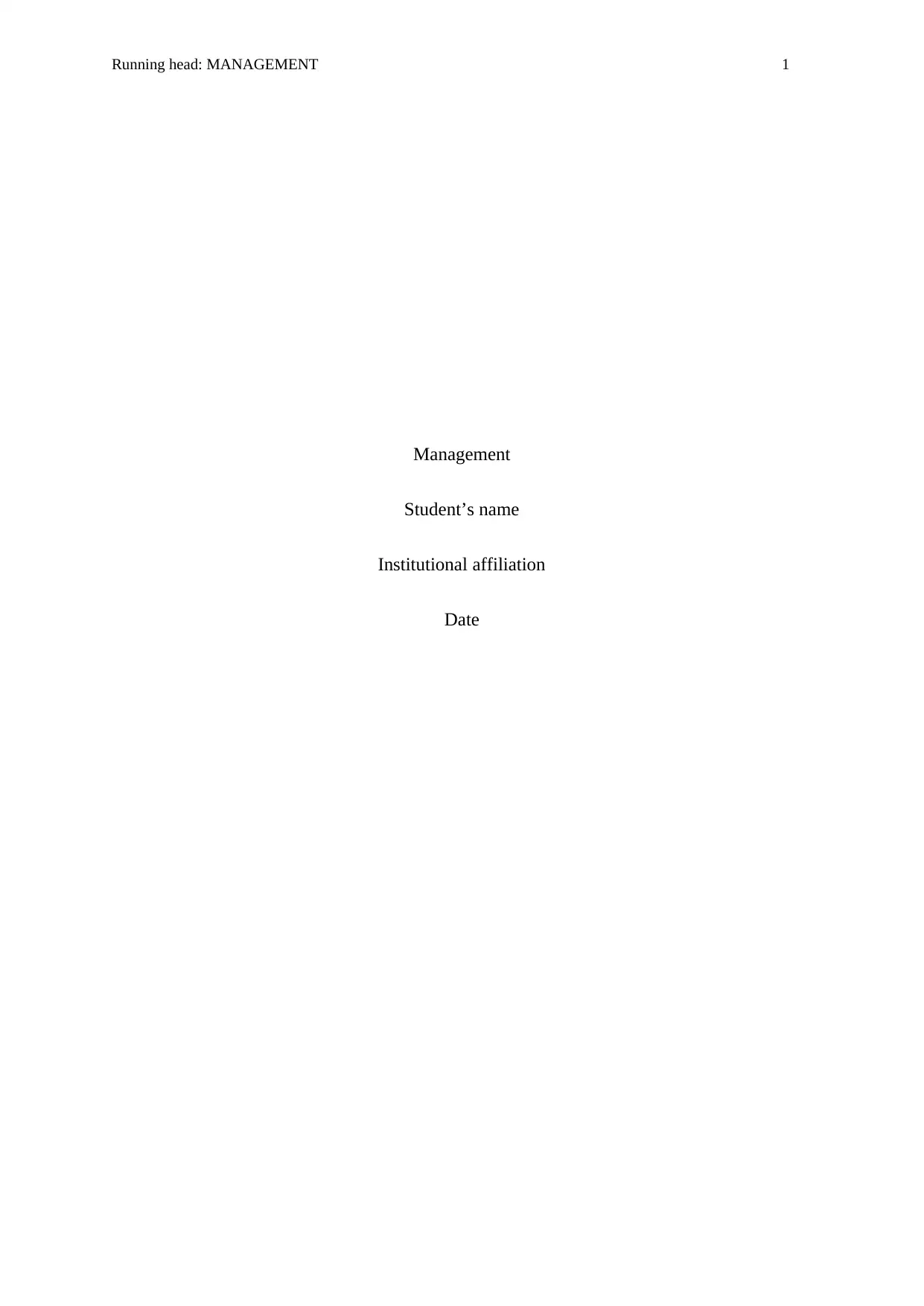
Running head: MANAGEMENT 1
Management
Student’s name
Institutional affiliation
Date
Management
Student’s name
Institutional affiliation
Date
Paraphrase This Document
Need a fresh take? Get an instant paraphrase of this document with our AI Paraphraser
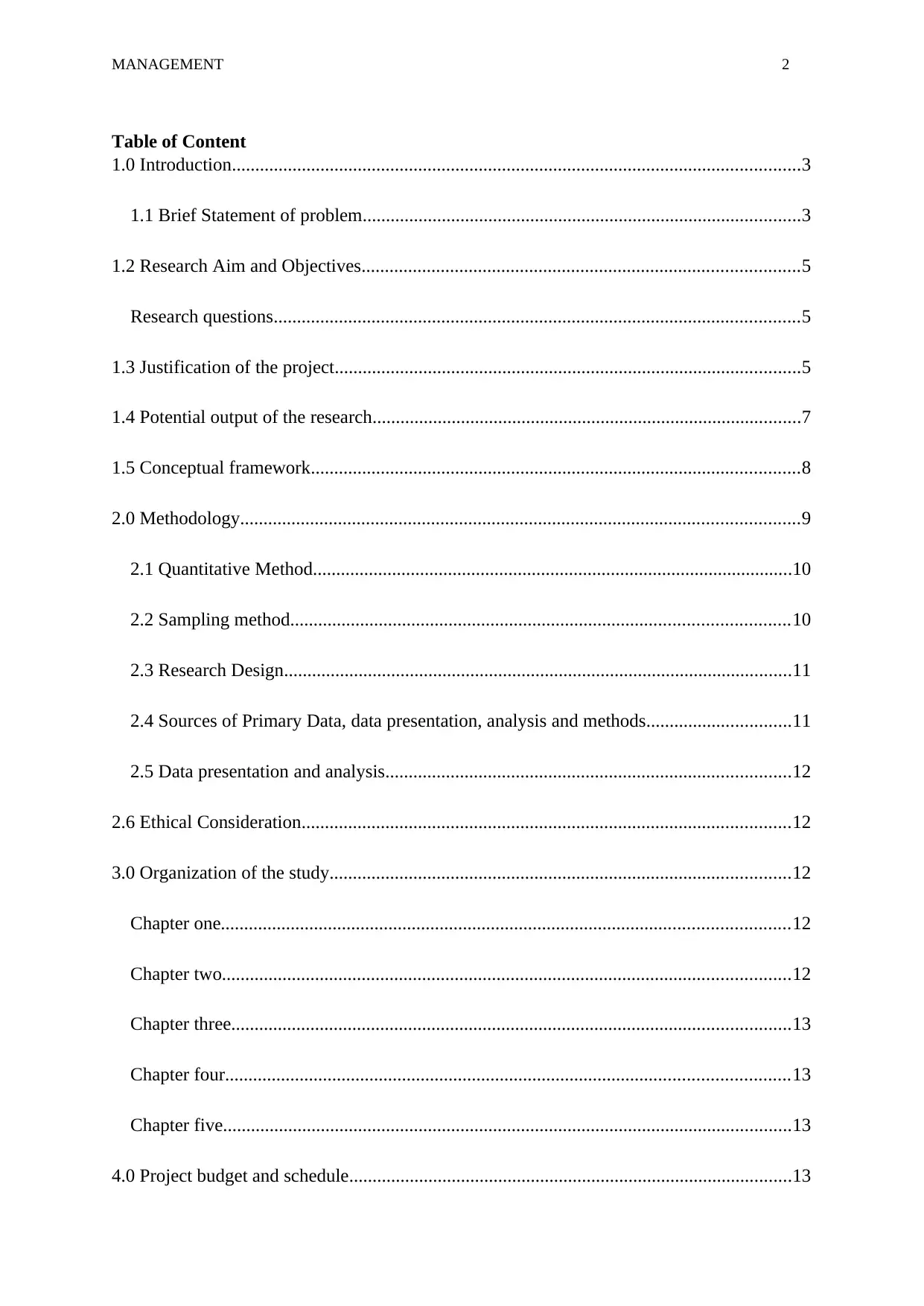
MANAGEMENT 2
Table of Content
1.0 Introduction..........................................................................................................................3
1.1 Brief Statement of problem..............................................................................................3
1.2 Research Aim and Objectives..............................................................................................5
Research questions.................................................................................................................5
1.3 Justification of the project....................................................................................................5
1.4 Potential output of the research............................................................................................7
1.5 Conceptual framework.........................................................................................................8
2.0 Methodology........................................................................................................................9
2.1 Quantitative Method.......................................................................................................10
2.2 Sampling method...........................................................................................................10
2.3 Research Design.............................................................................................................11
2.4 Sources of Primary Data, data presentation, analysis and methods...............................11
2.5 Data presentation and analysis.......................................................................................12
2.6 Ethical Consideration.........................................................................................................12
3.0 Organization of the study...................................................................................................12
Chapter one..........................................................................................................................12
Chapter two..........................................................................................................................12
Chapter three........................................................................................................................13
Chapter four.........................................................................................................................13
Chapter five..........................................................................................................................13
4.0 Project budget and schedule...............................................................................................13
Table of Content
1.0 Introduction..........................................................................................................................3
1.1 Brief Statement of problem..............................................................................................3
1.2 Research Aim and Objectives..............................................................................................5
Research questions.................................................................................................................5
1.3 Justification of the project....................................................................................................5
1.4 Potential output of the research............................................................................................7
1.5 Conceptual framework.........................................................................................................8
2.0 Methodology........................................................................................................................9
2.1 Quantitative Method.......................................................................................................10
2.2 Sampling method...........................................................................................................10
2.3 Research Design.............................................................................................................11
2.4 Sources of Primary Data, data presentation, analysis and methods...............................11
2.5 Data presentation and analysis.......................................................................................12
2.6 Ethical Consideration.........................................................................................................12
3.0 Organization of the study...................................................................................................12
Chapter one..........................................................................................................................12
Chapter two..........................................................................................................................12
Chapter three........................................................................................................................13
Chapter four.........................................................................................................................13
Chapter five..........................................................................................................................13
4.0 Project budget and schedule...............................................................................................13
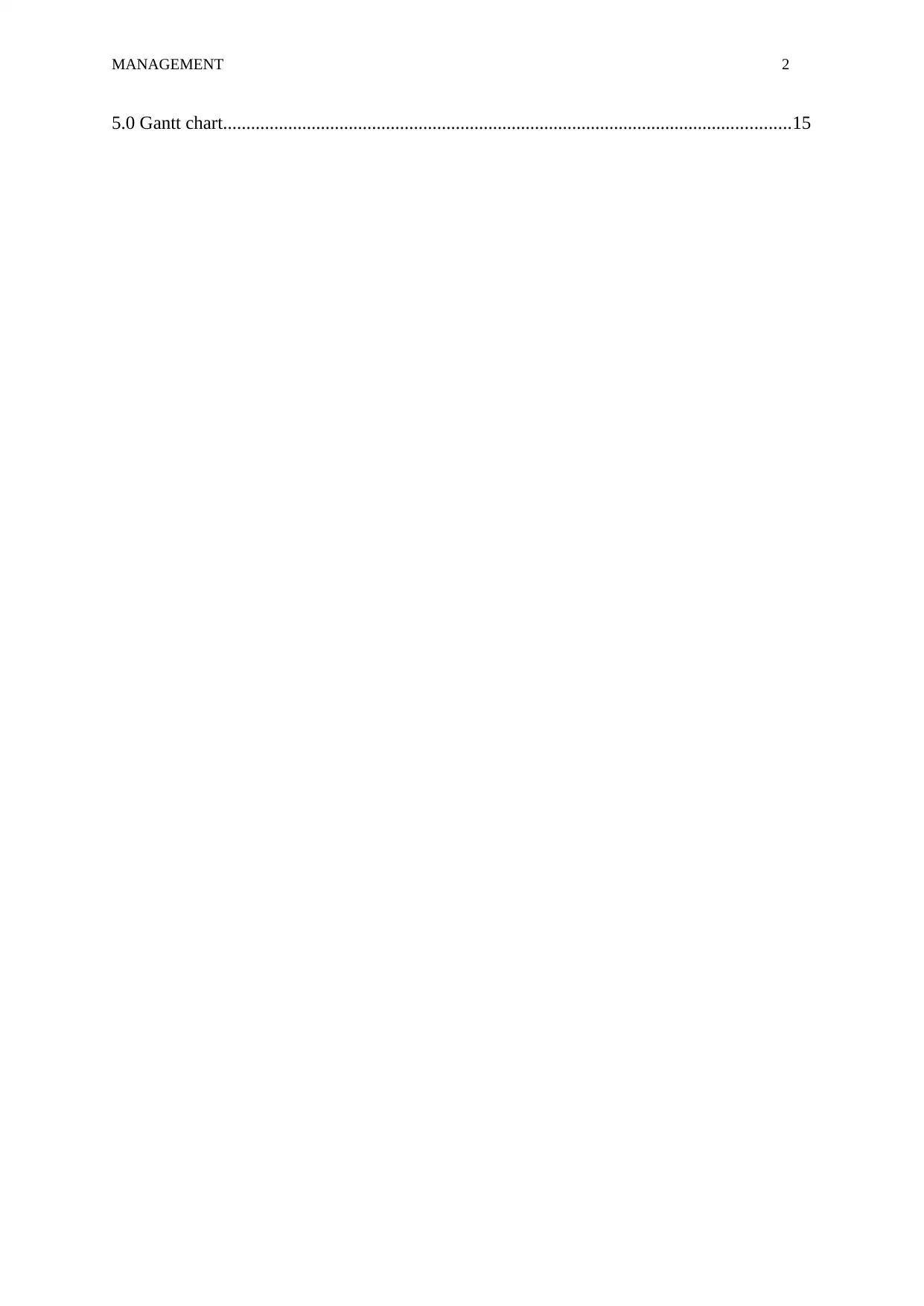
MANAGEMENT 2
5.0 Gantt chart..........................................................................................................................15
5.0 Gantt chart..........................................................................................................................15
⊘ This is a preview!⊘
Do you want full access?
Subscribe today to unlock all pages.

Trusted by 1+ million students worldwide
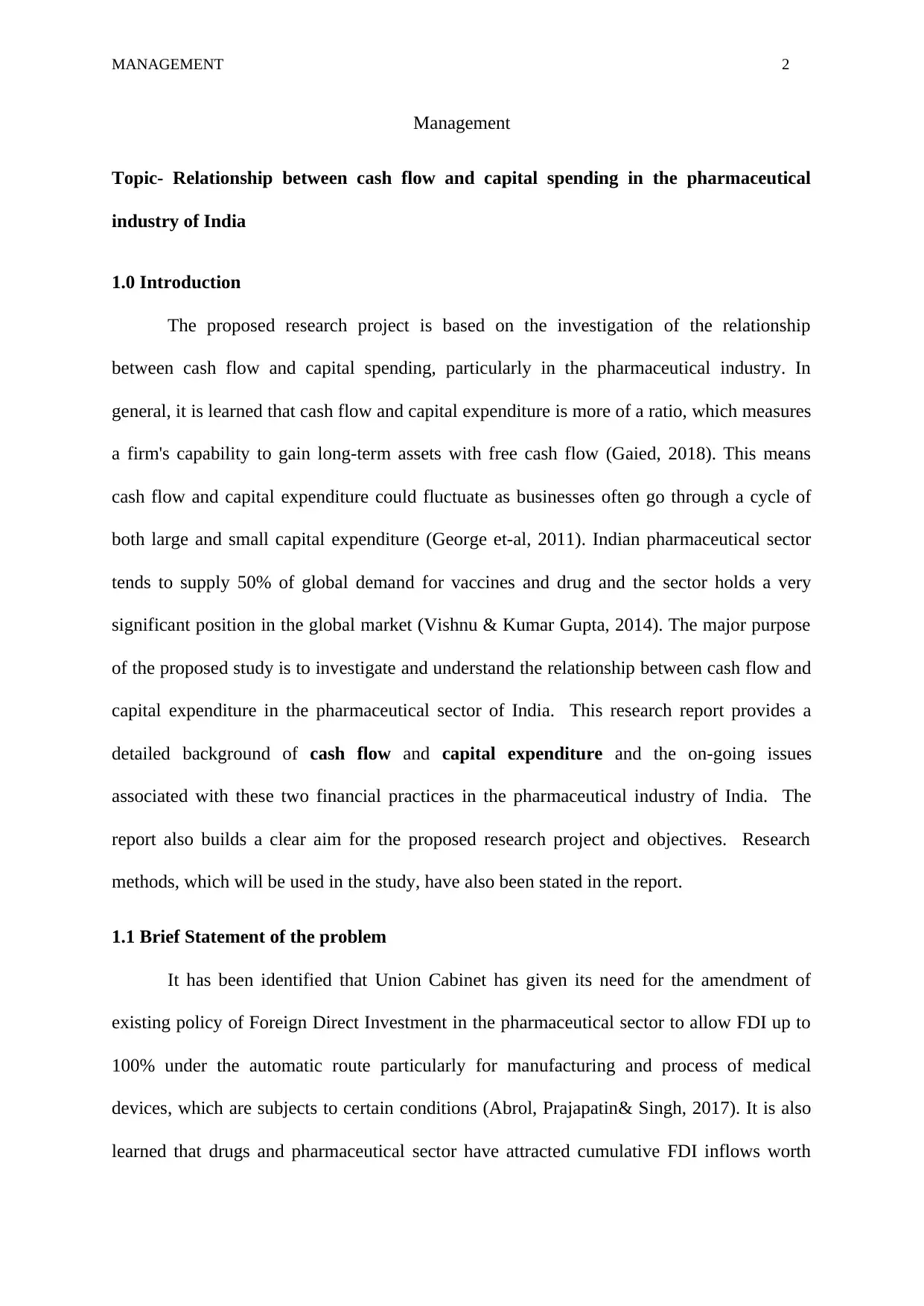
MANAGEMENT 2
Management
Topic- Relationship between cash flow and capital spending in the pharmaceutical
industry of India
1.0 Introduction
The proposed research project is based on the investigation of the relationship
between cash flow and capital spending, particularly in the pharmaceutical industry. In
general, it is learned that cash flow and capital expenditure is more of a ratio, which measures
a firm's capability to gain long-term assets with free cash flow (Gaied, 2018). This means
cash flow and capital expenditure could fluctuate as businesses often go through a cycle of
both large and small capital expenditure (George et-al, 2011). Indian pharmaceutical sector
tends to supply 50% of global demand for vaccines and drug and the sector holds a very
significant position in the global market (Vishnu & Kumar Gupta, 2014). The major purpose
of the proposed study is to investigate and understand the relationship between cash flow and
capital expenditure in the pharmaceutical sector of India. This research report provides a
detailed background of cash flow and capital expenditure and the on-going issues
associated with these two financial practices in the pharmaceutical industry of India. The
report also builds a clear aim for the proposed research project and objectives. Research
methods, which will be used in the study, have also been stated in the report.
1.1 Brief Statement of the problem
It has been identified that Union Cabinet has given its need for the amendment of
existing policy of Foreign Direct Investment in the pharmaceutical sector to allow FDI up to
100% under the automatic route particularly for manufacturing and process of medical
devices, which are subjects to certain conditions (Abrol, Prajapatin& Singh, 2017). It is also
learned that drugs and pharmaceutical sector have attracted cumulative FDI inflows worth
Management
Topic- Relationship between cash flow and capital spending in the pharmaceutical
industry of India
1.0 Introduction
The proposed research project is based on the investigation of the relationship
between cash flow and capital spending, particularly in the pharmaceutical industry. In
general, it is learned that cash flow and capital expenditure is more of a ratio, which measures
a firm's capability to gain long-term assets with free cash flow (Gaied, 2018). This means
cash flow and capital expenditure could fluctuate as businesses often go through a cycle of
both large and small capital expenditure (George et-al, 2011). Indian pharmaceutical sector
tends to supply 50% of global demand for vaccines and drug and the sector holds a very
significant position in the global market (Vishnu & Kumar Gupta, 2014). The major purpose
of the proposed study is to investigate and understand the relationship between cash flow and
capital expenditure in the pharmaceutical sector of India. This research report provides a
detailed background of cash flow and capital expenditure and the on-going issues
associated with these two financial practices in the pharmaceutical industry of India. The
report also builds a clear aim for the proposed research project and objectives. Research
methods, which will be used in the study, have also been stated in the report.
1.1 Brief Statement of the problem
It has been identified that Union Cabinet has given its need for the amendment of
existing policy of Foreign Direct Investment in the pharmaceutical sector to allow FDI up to
100% under the automatic route particularly for manufacturing and process of medical
devices, which are subjects to certain conditions (Abrol, Prajapatin& Singh, 2017). It is also
learned that drugs and pharmaceutical sector have attracted cumulative FDI inflows worth
Paraphrase This Document
Need a fresh take? Get an instant paraphrase of this document with our AI Paraphraser
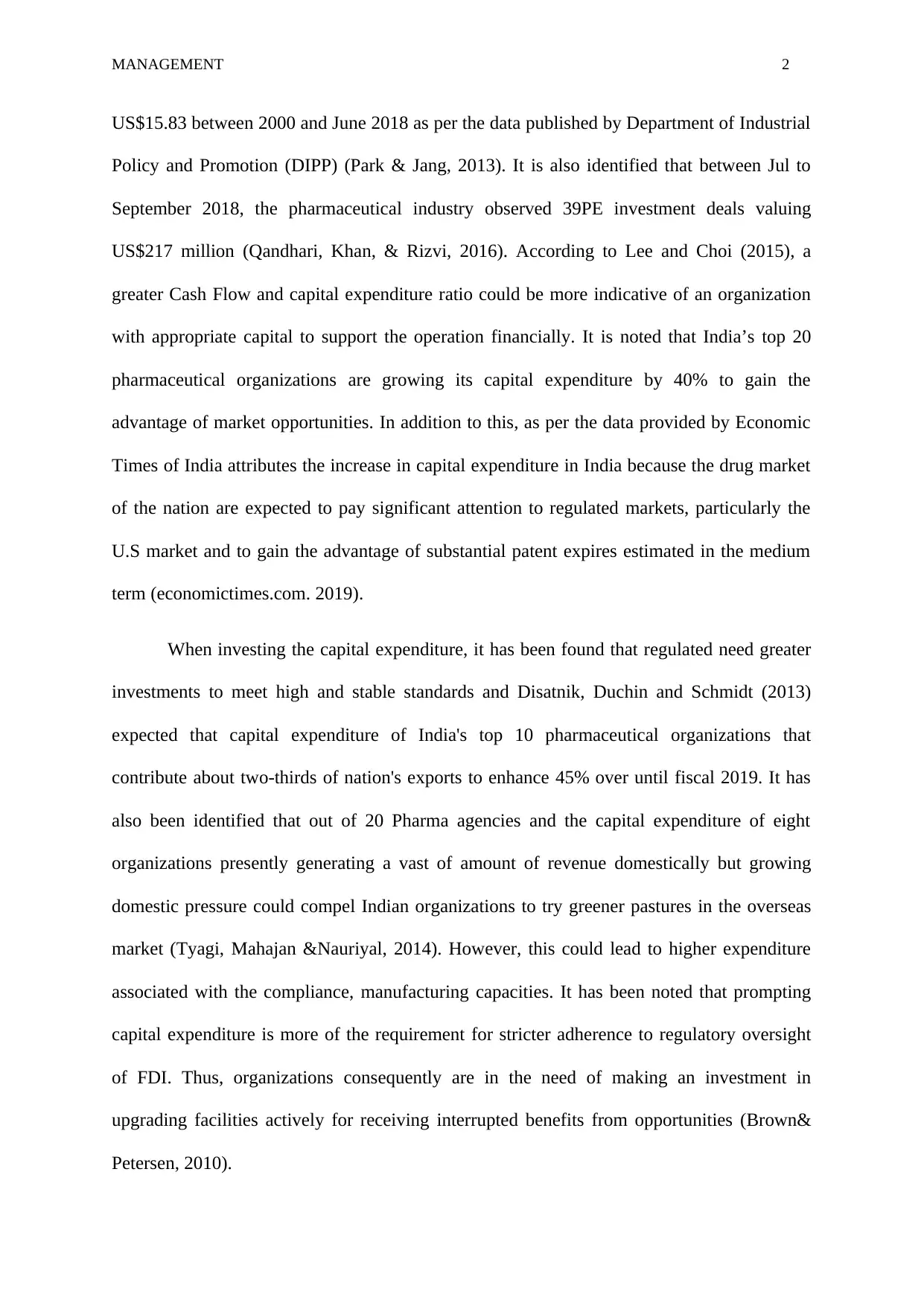
MANAGEMENT 2
US$15.83 between 2000 and June 2018 as per the data published by Department of Industrial
Policy and Promotion (DIPP) (Park & Jang, 2013). It is also identified that between Jul to
September 2018, the pharmaceutical industry observed 39PE investment deals valuing
US$217 million (Qandhari, Khan, & Rizvi, 2016). According to Lee and Choi (2015), a
greater Cash Flow and capital expenditure ratio could be more indicative of an organization
with appropriate capital to support the operation financially. It is noted that India’s top 20
pharmaceutical organizations are growing its capital expenditure by 40% to gain the
advantage of market opportunities. In addition to this, as per the data provided by Economic
Times of India attributes the increase in capital expenditure in India because the drug market
of the nation are expected to pay significant attention to regulated markets, particularly the
U.S market and to gain the advantage of substantial patent expires estimated in the medium
term (economictimes.com. 2019).
When investing the capital expenditure, it has been found that regulated need greater
investments to meet high and stable standards and Disatnik, Duchin and Schmidt (2013)
expected that capital expenditure of India's top 10 pharmaceutical organizations that
contribute about two-thirds of nation's exports to enhance 45% over until fiscal 2019. It has
also been identified that out of 20 Pharma agencies and the capital expenditure of eight
organizations presently generating a vast of amount of revenue domestically but growing
domestic pressure could compel Indian organizations to try greener pastures in the overseas
market (Tyagi, Mahajan &Nauriyal, 2014). However, this could lead to higher expenditure
associated with the compliance, manufacturing capacities. It has been noted that prompting
capital expenditure is more of the requirement for stricter adherence to regulatory oversight
of FDI. Thus, organizations consequently are in the need of making an investment in
upgrading facilities actively for receiving interrupted benefits from opportunities (Brown&
Petersen, 2010).
US$15.83 between 2000 and June 2018 as per the data published by Department of Industrial
Policy and Promotion (DIPP) (Park & Jang, 2013). It is also identified that between Jul to
September 2018, the pharmaceutical industry observed 39PE investment deals valuing
US$217 million (Qandhari, Khan, & Rizvi, 2016). According to Lee and Choi (2015), a
greater Cash Flow and capital expenditure ratio could be more indicative of an organization
with appropriate capital to support the operation financially. It is noted that India’s top 20
pharmaceutical organizations are growing its capital expenditure by 40% to gain the
advantage of market opportunities. In addition to this, as per the data provided by Economic
Times of India attributes the increase in capital expenditure in India because the drug market
of the nation are expected to pay significant attention to regulated markets, particularly the
U.S market and to gain the advantage of substantial patent expires estimated in the medium
term (economictimes.com. 2019).
When investing the capital expenditure, it has been found that regulated need greater
investments to meet high and stable standards and Disatnik, Duchin and Schmidt (2013)
expected that capital expenditure of India's top 10 pharmaceutical organizations that
contribute about two-thirds of nation's exports to enhance 45% over until fiscal 2019. It has
also been identified that out of 20 Pharma agencies and the capital expenditure of eight
organizations presently generating a vast of amount of revenue domestically but growing
domestic pressure could compel Indian organizations to try greener pastures in the overseas
market (Tyagi, Mahajan &Nauriyal, 2014). However, this could lead to higher expenditure
associated with the compliance, manufacturing capacities. It has been noted that prompting
capital expenditure is more of the requirement for stricter adherence to regulatory oversight
of FDI. Thus, organizations consequently are in the need of making an investment in
upgrading facilities actively for receiving interrupted benefits from opportunities (Brown&
Petersen, 2010).
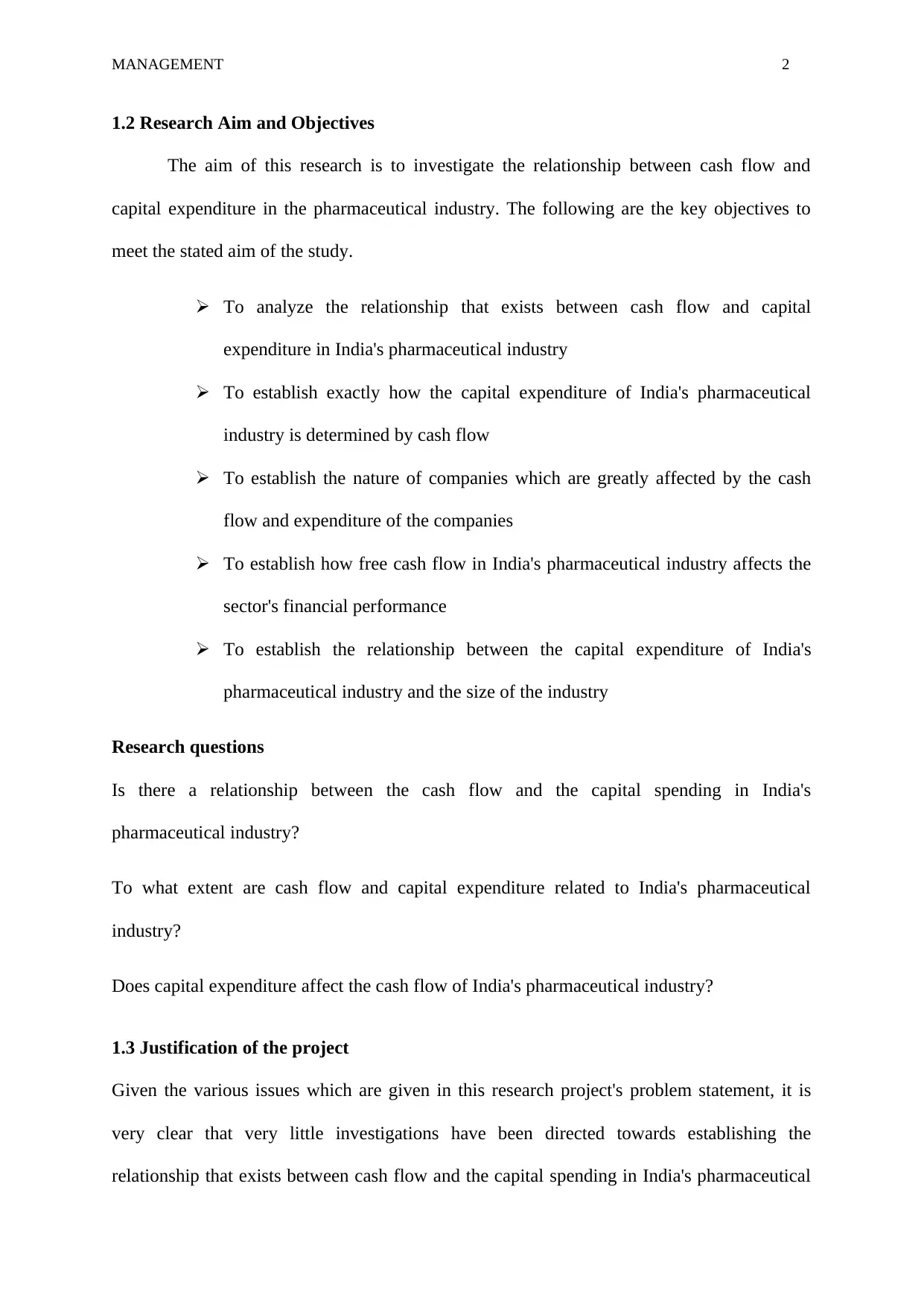
MANAGEMENT 2
1.2 Research Aim and Objectives
The aim of this research is to investigate the relationship between cash flow and
capital expenditure in the pharmaceutical industry. The following are the key objectives to
meet the stated aim of the study.
To analyze the relationship that exists between cash flow and capital
expenditure in India's pharmaceutical industry
To establish exactly how the capital expenditure of India's pharmaceutical
industry is determined by cash flow
To establish the nature of companies which are greatly affected by the cash
flow and expenditure of the companies
To establish how free cash flow in India's pharmaceutical industry affects the
sector's financial performance
To establish the relationship between the capital expenditure of India's
pharmaceutical industry and the size of the industry
Research questions
Is there a relationship between the cash flow and the capital spending in India's
pharmaceutical industry?
To what extent are cash flow and capital expenditure related to India's pharmaceutical
industry?
Does capital expenditure affect the cash flow of India's pharmaceutical industry?
1.3 Justification of the project
Given the various issues which are given in this research project's problem statement, it is
very clear that very little investigations have been directed towards establishing the
relationship that exists between cash flow and the capital spending in India's pharmaceutical
1.2 Research Aim and Objectives
The aim of this research is to investigate the relationship between cash flow and
capital expenditure in the pharmaceutical industry. The following are the key objectives to
meet the stated aim of the study.
To analyze the relationship that exists between cash flow and capital
expenditure in India's pharmaceutical industry
To establish exactly how the capital expenditure of India's pharmaceutical
industry is determined by cash flow
To establish the nature of companies which are greatly affected by the cash
flow and expenditure of the companies
To establish how free cash flow in India's pharmaceutical industry affects the
sector's financial performance
To establish the relationship between the capital expenditure of India's
pharmaceutical industry and the size of the industry
Research questions
Is there a relationship between the cash flow and the capital spending in India's
pharmaceutical industry?
To what extent are cash flow and capital expenditure related to India's pharmaceutical
industry?
Does capital expenditure affect the cash flow of India's pharmaceutical industry?
1.3 Justification of the project
Given the various issues which are given in this research project's problem statement, it is
very clear that very little investigations have been directed towards establishing the
relationship that exists between cash flow and the capital spending in India's pharmaceutical
⊘ This is a preview!⊘
Do you want full access?
Subscribe today to unlock all pages.

Trusted by 1+ million students worldwide
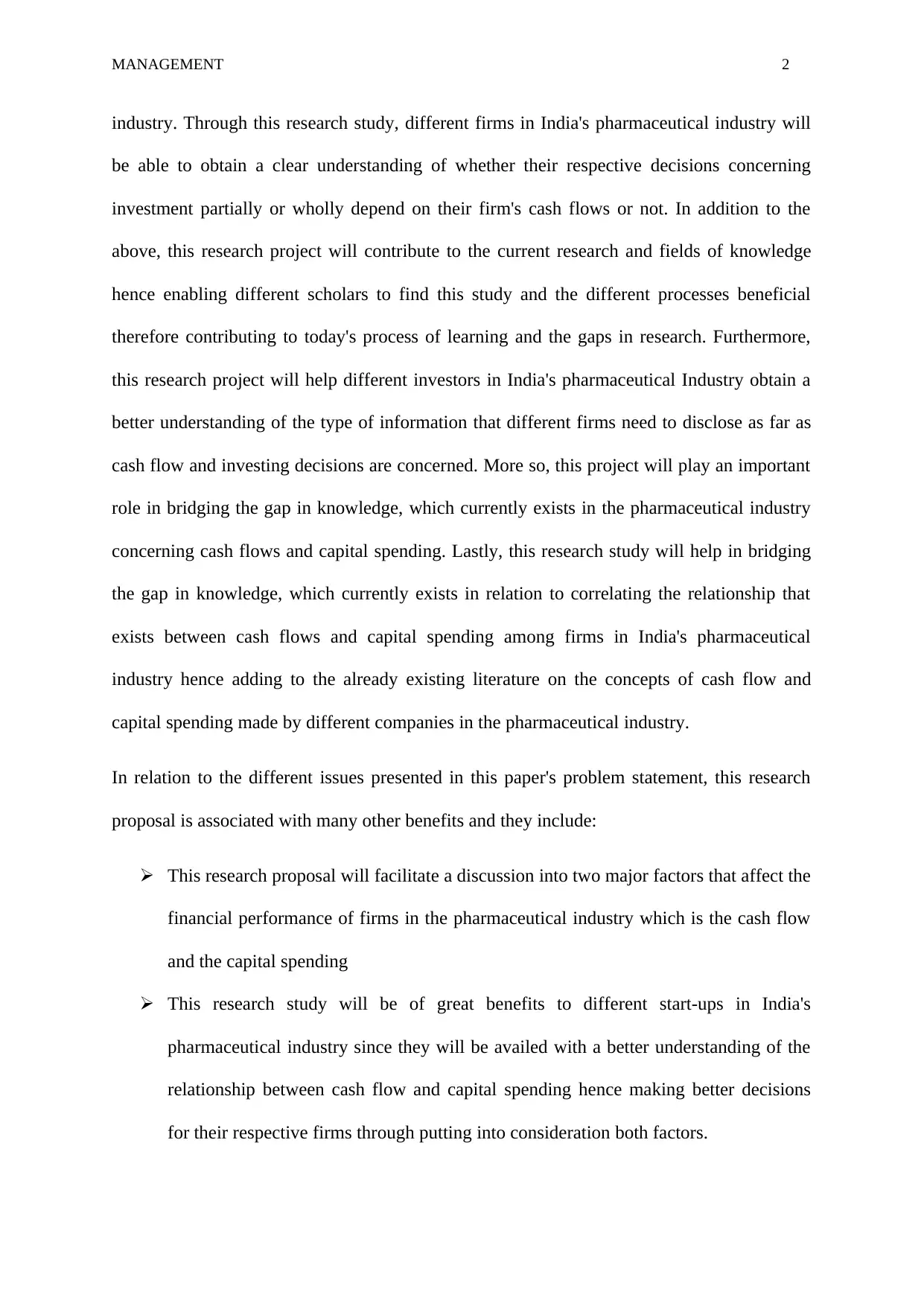
MANAGEMENT 2
industry. Through this research study, different firms in India's pharmaceutical industry will
be able to obtain a clear understanding of whether their respective decisions concerning
investment partially or wholly depend on their firm's cash flows or not. In addition to the
above, this research project will contribute to the current research and fields of knowledge
hence enabling different scholars to find this study and the different processes beneficial
therefore contributing to today's process of learning and the gaps in research. Furthermore,
this research project will help different investors in India's pharmaceutical Industry obtain a
better understanding of the type of information that different firms need to disclose as far as
cash flow and investing decisions are concerned. More so, this project will play an important
role in bridging the gap in knowledge, which currently exists in the pharmaceutical industry
concerning cash flows and capital spending. Lastly, this research study will help in bridging
the gap in knowledge, which currently exists in relation to correlating the relationship that
exists between cash flows and capital spending among firms in India's pharmaceutical
industry hence adding to the already existing literature on the concepts of cash flow and
capital spending made by different companies in the pharmaceutical industry.
In relation to the different issues presented in this paper's problem statement, this research
proposal is associated with many other benefits and they include:
This research proposal will facilitate a discussion into two major factors that affect the
financial performance of firms in the pharmaceutical industry which is the cash flow
and the capital spending
This research study will be of great benefits to different start-ups in India's
pharmaceutical industry since they will be availed with a better understanding of the
relationship between cash flow and capital spending hence making better decisions
for their respective firms through putting into consideration both factors.
industry. Through this research study, different firms in India's pharmaceutical industry will
be able to obtain a clear understanding of whether their respective decisions concerning
investment partially or wholly depend on their firm's cash flows or not. In addition to the
above, this research project will contribute to the current research and fields of knowledge
hence enabling different scholars to find this study and the different processes beneficial
therefore contributing to today's process of learning and the gaps in research. Furthermore,
this research project will help different investors in India's pharmaceutical Industry obtain a
better understanding of the type of information that different firms need to disclose as far as
cash flow and investing decisions are concerned. More so, this project will play an important
role in bridging the gap in knowledge, which currently exists in the pharmaceutical industry
concerning cash flows and capital spending. Lastly, this research study will help in bridging
the gap in knowledge, which currently exists in relation to correlating the relationship that
exists between cash flows and capital spending among firms in India's pharmaceutical
industry hence adding to the already existing literature on the concepts of cash flow and
capital spending made by different companies in the pharmaceutical industry.
In relation to the different issues presented in this paper's problem statement, this research
proposal is associated with many other benefits and they include:
This research proposal will facilitate a discussion into two major factors that affect the
financial performance of firms in the pharmaceutical industry which is the cash flow
and the capital spending
This research study will be of great benefits to different start-ups in India's
pharmaceutical industry since they will be availed with a better understanding of the
relationship between cash flow and capital spending hence making better decisions
for their respective firms through putting into consideration both factors.
Paraphrase This Document
Need a fresh take? Get an instant paraphrase of this document with our AI Paraphraser
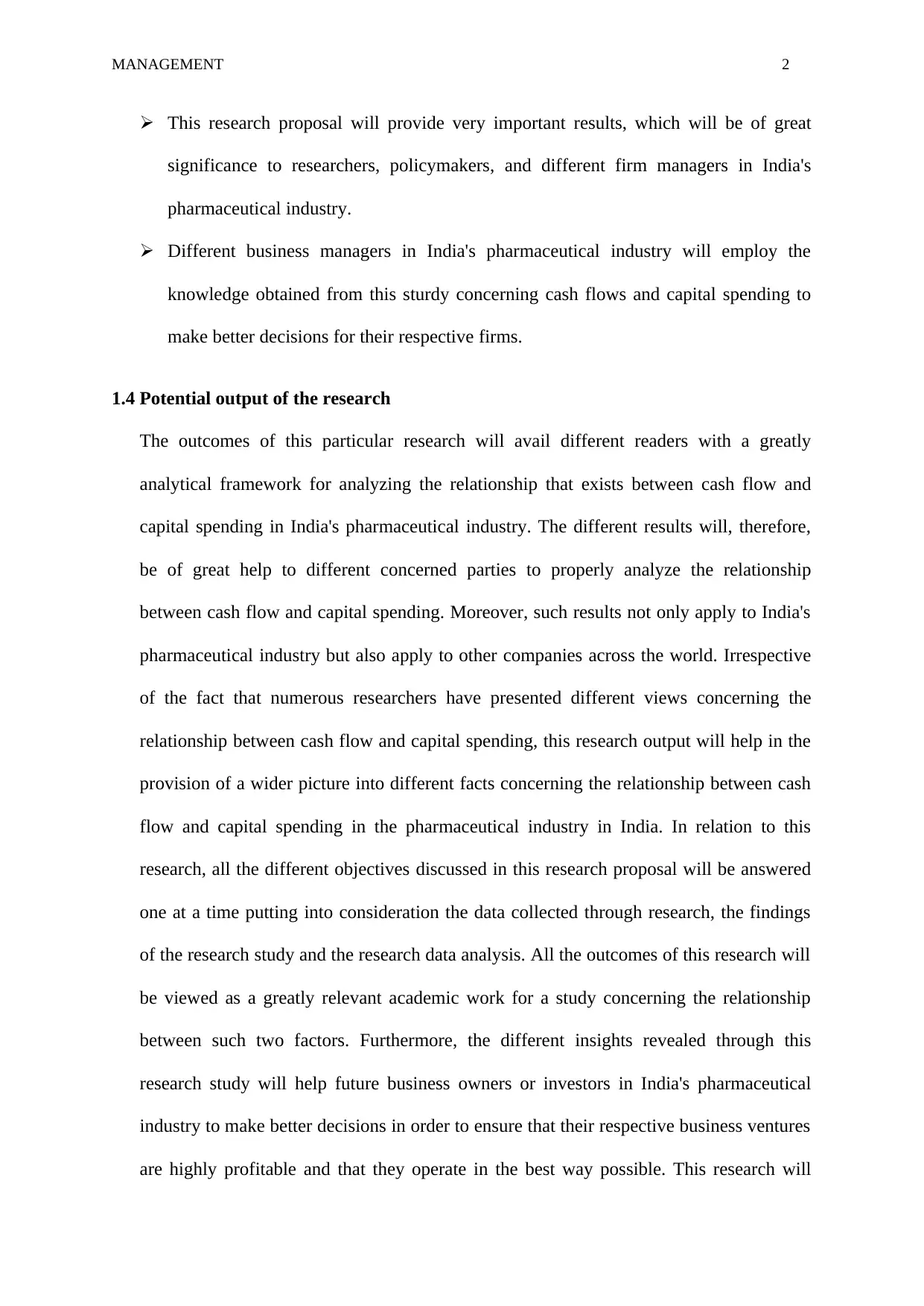
MANAGEMENT 2
This research proposal will provide very important results, which will be of great
significance to researchers, policymakers, and different firm managers in India's
pharmaceutical industry.
Different business managers in India's pharmaceutical industry will employ the
knowledge obtained from this sturdy concerning cash flows and capital spending to
make better decisions for their respective firms.
1.4 Potential output of the research
The outcomes of this particular research will avail different readers with a greatly
analytical framework for analyzing the relationship that exists between cash flow and
capital spending in India's pharmaceutical industry. The different results will, therefore,
be of great help to different concerned parties to properly analyze the relationship
between cash flow and capital spending. Moreover, such results not only apply to India's
pharmaceutical industry but also apply to other companies across the world. Irrespective
of the fact that numerous researchers have presented different views concerning the
relationship between cash flow and capital spending, this research output will help in the
provision of a wider picture into different facts concerning the relationship between cash
flow and capital spending in the pharmaceutical industry in India. In relation to this
research, all the different objectives discussed in this research proposal will be answered
one at a time putting into consideration the data collected through research, the findings
of the research study and the research data analysis. All the outcomes of this research will
be viewed as a greatly relevant academic work for a study concerning the relationship
between such two factors. Furthermore, the different insights revealed through this
research study will help future business owners or investors in India's pharmaceutical
industry to make better decisions in order to ensure that their respective business ventures
are highly profitable and that they operate in the best way possible. This research will
This research proposal will provide very important results, which will be of great
significance to researchers, policymakers, and different firm managers in India's
pharmaceutical industry.
Different business managers in India's pharmaceutical industry will employ the
knowledge obtained from this sturdy concerning cash flows and capital spending to
make better decisions for their respective firms.
1.4 Potential output of the research
The outcomes of this particular research will avail different readers with a greatly
analytical framework for analyzing the relationship that exists between cash flow and
capital spending in India's pharmaceutical industry. The different results will, therefore,
be of great help to different concerned parties to properly analyze the relationship
between cash flow and capital spending. Moreover, such results not only apply to India's
pharmaceutical industry but also apply to other companies across the world. Irrespective
of the fact that numerous researchers have presented different views concerning the
relationship between cash flow and capital spending, this research output will help in the
provision of a wider picture into different facts concerning the relationship between cash
flow and capital spending in the pharmaceutical industry in India. In relation to this
research, all the different objectives discussed in this research proposal will be answered
one at a time putting into consideration the data collected through research, the findings
of the research study and the research data analysis. All the outcomes of this research will
be viewed as a greatly relevant academic work for a study concerning the relationship
between such two factors. Furthermore, the different insights revealed through this
research study will help future business owners or investors in India's pharmaceutical
industry to make better decisions in order to ensure that their respective business ventures
are highly profitable and that they operate in the best way possible. This research will
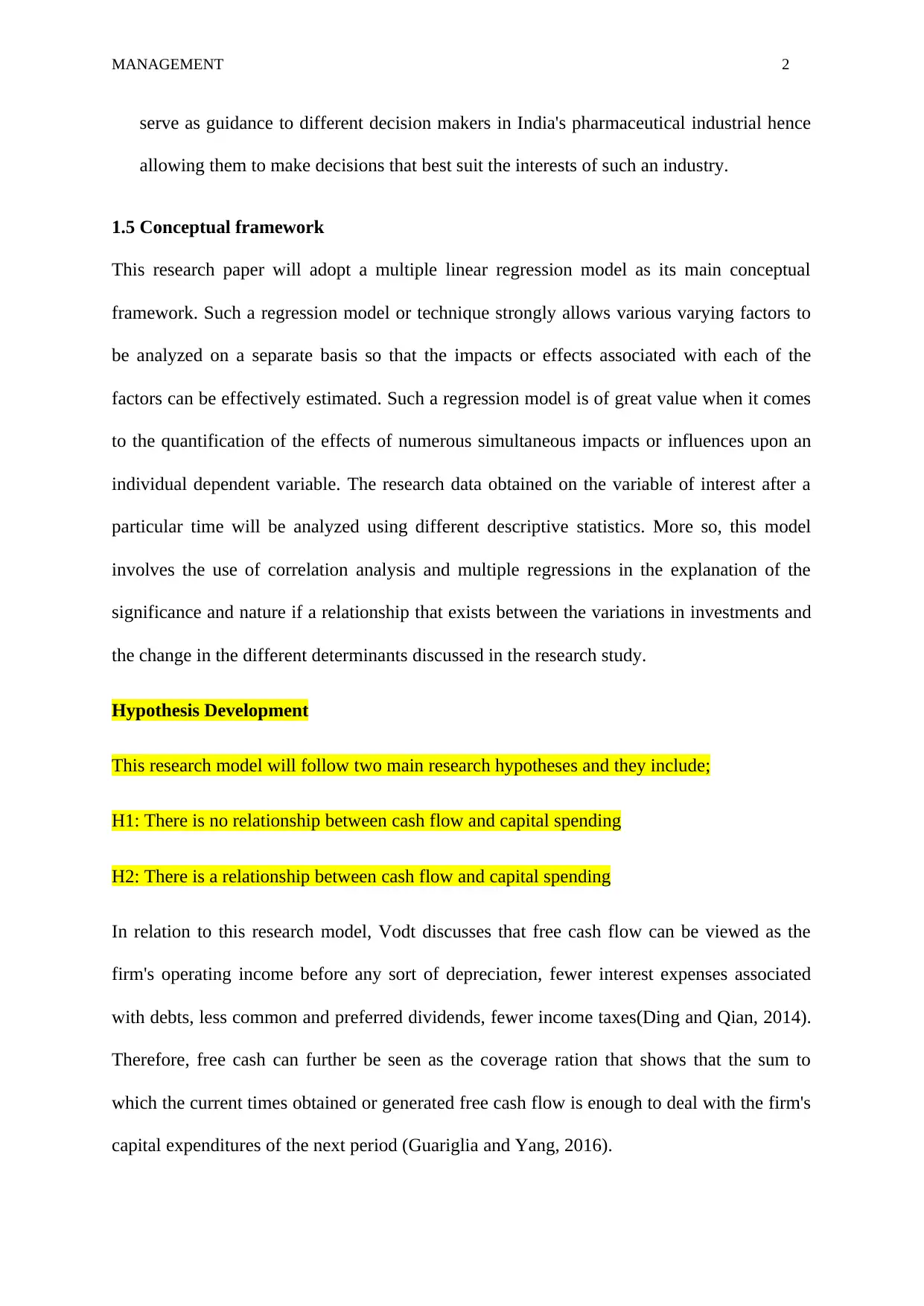
MANAGEMENT 2
serve as guidance to different decision makers in India's pharmaceutical industrial hence
allowing them to make decisions that best suit the interests of such an industry.
1.5 Conceptual framework
This research paper will adopt a multiple linear regression model as its main conceptual
framework. Such a regression model or technique strongly allows various varying factors to
be analyzed on a separate basis so that the impacts or effects associated with each of the
factors can be effectively estimated. Such a regression model is of great value when it comes
to the quantification of the effects of numerous simultaneous impacts or influences upon an
individual dependent variable. The research data obtained on the variable of interest after a
particular time will be analyzed using different descriptive statistics. More so, this model
involves the use of correlation analysis and multiple regressions in the explanation of the
significance and nature if a relationship that exists between the variations in investments and
the change in the different determinants discussed in the research study.
Hypothesis Development
This research model will follow two main research hypotheses and they include;
H1: There is no relationship between cash flow and capital spending
H2: There is a relationship between cash flow and capital spending
In relation to this research model, Vodt discusses that free cash flow can be viewed as the
firm's operating income before any sort of depreciation, fewer interest expenses associated
with debts, less common and preferred dividends, fewer income taxes(Ding and Qian, 2014).
Therefore, free cash can further be seen as the coverage ration that shows that the sum to
which the current times obtained or generated free cash flow is enough to deal with the firm's
capital expenditures of the next period (Guariglia and Yang, 2016).
serve as guidance to different decision makers in India's pharmaceutical industrial hence
allowing them to make decisions that best suit the interests of such an industry.
1.5 Conceptual framework
This research paper will adopt a multiple linear regression model as its main conceptual
framework. Such a regression model or technique strongly allows various varying factors to
be analyzed on a separate basis so that the impacts or effects associated with each of the
factors can be effectively estimated. Such a regression model is of great value when it comes
to the quantification of the effects of numerous simultaneous impacts or influences upon an
individual dependent variable. The research data obtained on the variable of interest after a
particular time will be analyzed using different descriptive statistics. More so, this model
involves the use of correlation analysis and multiple regressions in the explanation of the
significance and nature if a relationship that exists between the variations in investments and
the change in the different determinants discussed in the research study.
Hypothesis Development
This research model will follow two main research hypotheses and they include;
H1: There is no relationship between cash flow and capital spending
H2: There is a relationship between cash flow and capital spending
In relation to this research model, Vodt discusses that free cash flow can be viewed as the
firm's operating income before any sort of depreciation, fewer interest expenses associated
with debts, less common and preferred dividends, fewer income taxes(Ding and Qian, 2014).
Therefore, free cash can further be seen as the coverage ration that shows that the sum to
which the current times obtained or generated free cash flow is enough to deal with the firm's
capital expenditures of the next period (Guariglia and Yang, 2016).
⊘ This is a preview!⊘
Do you want full access?
Subscribe today to unlock all pages.

Trusted by 1+ million students worldwide
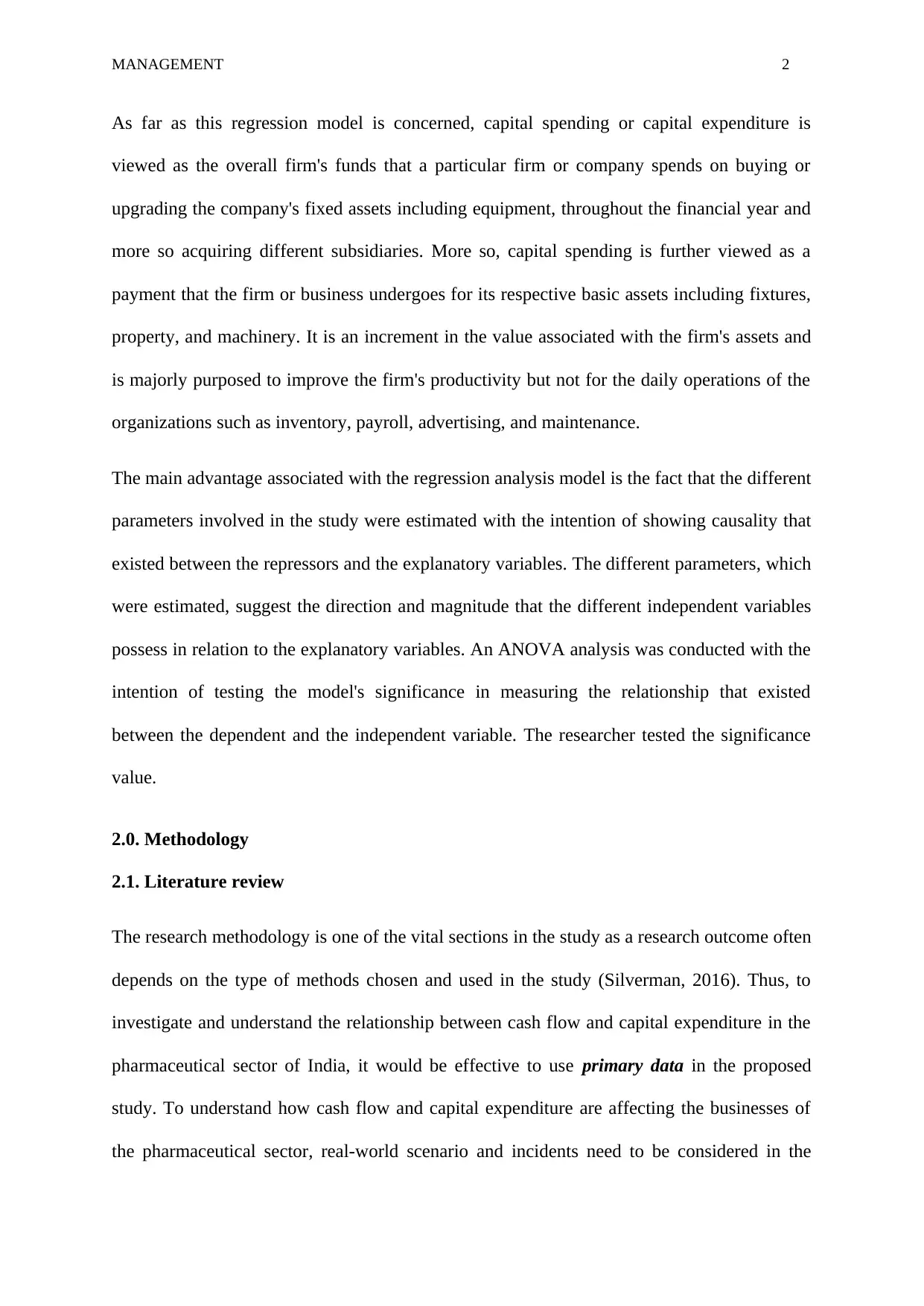
MANAGEMENT 2
As far as this regression model is concerned, capital spending or capital expenditure is
viewed as the overall firm's funds that a particular firm or company spends on buying or
upgrading the company's fixed assets including equipment, throughout the financial year and
more so acquiring different subsidiaries. More so, capital spending is further viewed as a
payment that the firm or business undergoes for its respective basic assets including fixtures,
property, and machinery. It is an increment in the value associated with the firm's assets and
is majorly purposed to improve the firm's productivity but not for the daily operations of the
organizations such as inventory, payroll, advertising, and maintenance.
The main advantage associated with the regression analysis model is the fact that the different
parameters involved in the study were estimated with the intention of showing causality that
existed between the repressors and the explanatory variables. The different parameters, which
were estimated, suggest the direction and magnitude that the different independent variables
possess in relation to the explanatory variables. An ANOVA analysis was conducted with the
intention of testing the model's significance in measuring the relationship that existed
between the dependent and the independent variable. The researcher tested the significance
value.
2.0. Methodology
2.1. Literature review
The research methodology is one of the vital sections in the study as a research outcome often
depends on the type of methods chosen and used in the study (Silverman, 2016). Thus, to
investigate and understand the relationship between cash flow and capital expenditure in the
pharmaceutical sector of India, it would be effective to use primary data in the proposed
study. To understand how cash flow and capital expenditure are affecting the businesses of
the pharmaceutical sector, real-world scenario and incidents need to be considered in the
As far as this regression model is concerned, capital spending or capital expenditure is
viewed as the overall firm's funds that a particular firm or company spends on buying or
upgrading the company's fixed assets including equipment, throughout the financial year and
more so acquiring different subsidiaries. More so, capital spending is further viewed as a
payment that the firm or business undergoes for its respective basic assets including fixtures,
property, and machinery. It is an increment in the value associated with the firm's assets and
is majorly purposed to improve the firm's productivity but not for the daily operations of the
organizations such as inventory, payroll, advertising, and maintenance.
The main advantage associated with the regression analysis model is the fact that the different
parameters involved in the study were estimated with the intention of showing causality that
existed between the repressors and the explanatory variables. The different parameters, which
were estimated, suggest the direction and magnitude that the different independent variables
possess in relation to the explanatory variables. An ANOVA analysis was conducted with the
intention of testing the model's significance in measuring the relationship that existed
between the dependent and the independent variable. The researcher tested the significance
value.
2.0. Methodology
2.1. Literature review
The research methodology is one of the vital sections in the study as a research outcome often
depends on the type of methods chosen and used in the study (Silverman, 2016). Thus, to
investigate and understand the relationship between cash flow and capital expenditure in the
pharmaceutical sector of India, it would be effective to use primary data in the proposed
study. To understand how cash flow and capital expenditure are affecting the businesses of
the pharmaceutical sector, real-world scenario and incidents need to be considered in the
Paraphrase This Document
Need a fresh take? Get an instant paraphrase of this document with our AI Paraphraser
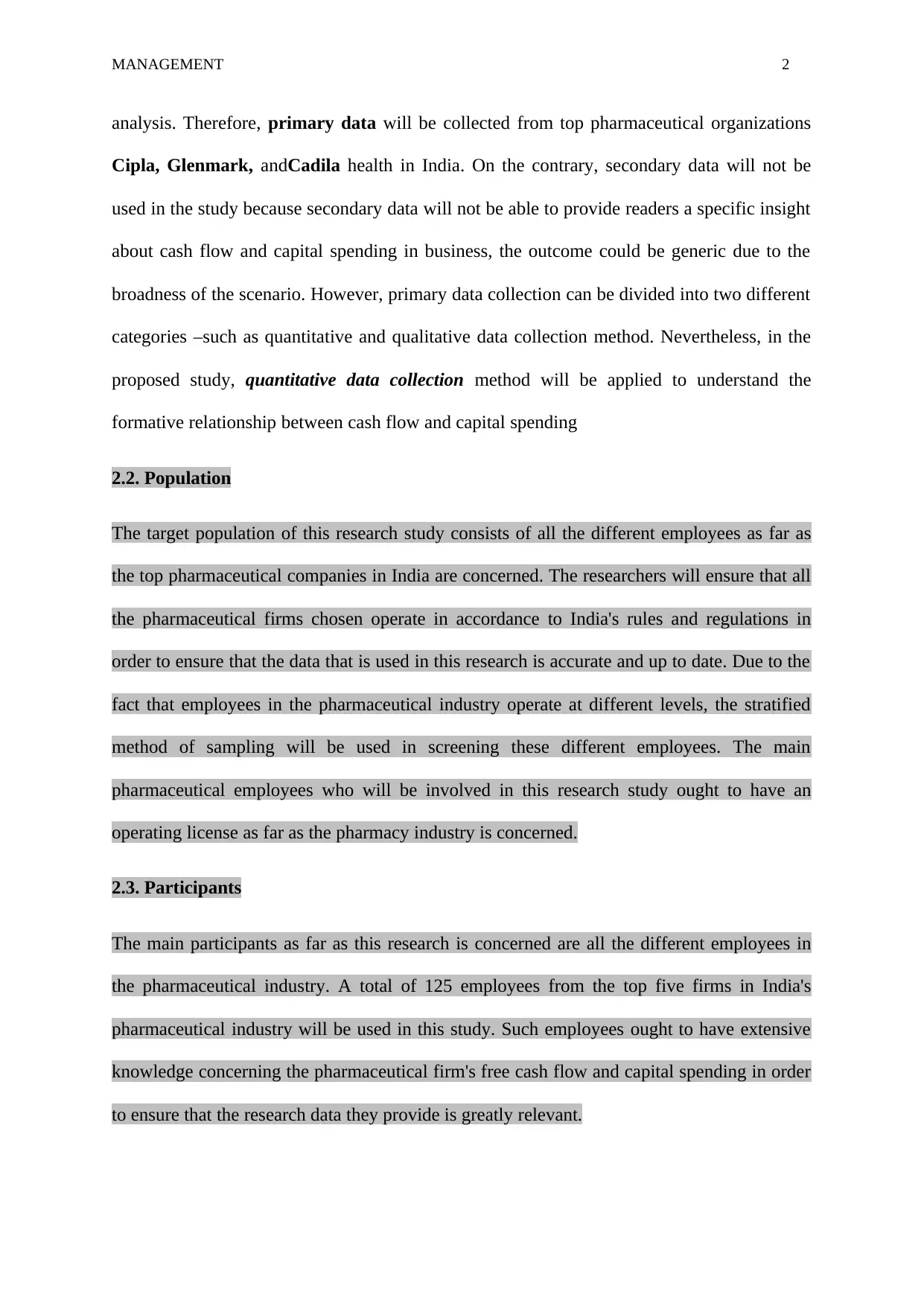
MANAGEMENT 2
analysis. Therefore, primary data will be collected from top pharmaceutical organizations
Cipla, Glenmark, andCadila health in India. On the contrary, secondary data will not be
used in the study because secondary data will not be able to provide readers a specific insight
about cash flow and capital spending in business, the outcome could be generic due to the
broadness of the scenario. However, primary data collection can be divided into two different
categories –such as quantitative and qualitative data collection method. Nevertheless, in the
proposed study, quantitative data collection method will be applied to understand the
formative relationship between cash flow and capital spending
2.2. Population
The target population of this research study consists of all the different employees as far as
the top pharmaceutical companies in India are concerned. The researchers will ensure that all
the pharmaceutical firms chosen operate in accordance to India's rules and regulations in
order to ensure that the data that is used in this research is accurate and up to date. Due to the
fact that employees in the pharmaceutical industry operate at different levels, the stratified
method of sampling will be used in screening these different employees. The main
pharmaceutical employees who will be involved in this research study ought to have an
operating license as far as the pharmacy industry is concerned.
2.3. Participants
The main participants as far as this research is concerned are all the different employees in
the pharmaceutical industry. A total of 125 employees from the top five firms in India's
pharmaceutical industry will be used in this study. Such employees ought to have extensive
knowledge concerning the pharmaceutical firm's free cash flow and capital spending in order
to ensure that the research data they provide is greatly relevant.
analysis. Therefore, primary data will be collected from top pharmaceutical organizations
Cipla, Glenmark, andCadila health in India. On the contrary, secondary data will not be
used in the study because secondary data will not be able to provide readers a specific insight
about cash flow and capital spending in business, the outcome could be generic due to the
broadness of the scenario. However, primary data collection can be divided into two different
categories –such as quantitative and qualitative data collection method. Nevertheless, in the
proposed study, quantitative data collection method will be applied to understand the
formative relationship between cash flow and capital spending
2.2. Population
The target population of this research study consists of all the different employees as far as
the top pharmaceutical companies in India are concerned. The researchers will ensure that all
the pharmaceutical firms chosen operate in accordance to India's rules and regulations in
order to ensure that the data that is used in this research is accurate and up to date. Due to the
fact that employees in the pharmaceutical industry operate at different levels, the stratified
method of sampling will be used in screening these different employees. The main
pharmaceutical employees who will be involved in this research study ought to have an
operating license as far as the pharmacy industry is concerned.
2.3. Participants
The main participants as far as this research is concerned are all the different employees in
the pharmaceutical industry. A total of 125 employees from the top five firms in India's
pharmaceutical industry will be used in this study. Such employees ought to have extensive
knowledge concerning the pharmaceutical firm's free cash flow and capital spending in order
to ensure that the research data they provide is greatly relevant.
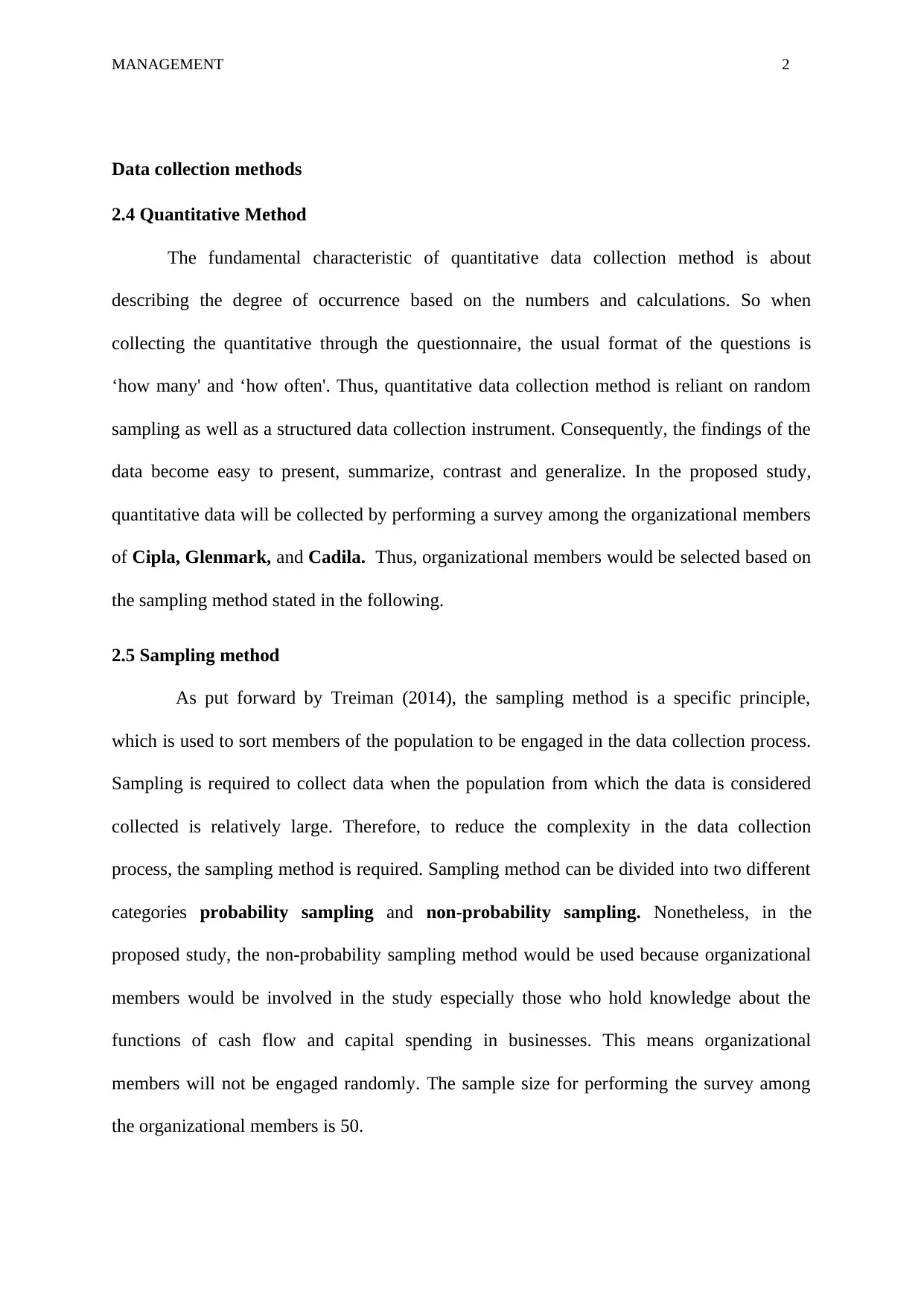
MANAGEMENT 2
Data collection methods
2.4 Quantitative Method
The fundamental characteristic of quantitative data collection method is about
describing the degree of occurrence based on the numbers and calculations. So when
collecting the quantitative through the questionnaire, the usual format of the questions is
‘how many' and ‘how often'. Thus, quantitative data collection method is reliant on random
sampling as well as a structured data collection instrument. Consequently, the findings of the
data become easy to present, summarize, contrast and generalize. In the proposed study,
quantitative data will be collected by performing a survey among the organizational members
of Cipla, Glenmark, and Cadila. Thus, organizational members would be selected based on
the sampling method stated in the following.
2.5 Sampling method
As put forward by Treiman (2014), the sampling method is a specific principle,
which is used to sort members of the population to be engaged in the data collection process.
Sampling is required to collect data when the population from which the data is considered
collected is relatively large. Therefore, to reduce the complexity in the data collection
process, the sampling method is required. Sampling method can be divided into two different
categories probability sampling and non-probability sampling. Nonetheless, in the
proposed study, the non-probability sampling method would be used because organizational
members would be involved in the study especially those who hold knowledge about the
functions of cash flow and capital spending in businesses. This means organizational
members will not be engaged randomly. The sample size for performing the survey among
the organizational members is 50.
Data collection methods
2.4 Quantitative Method
The fundamental characteristic of quantitative data collection method is about
describing the degree of occurrence based on the numbers and calculations. So when
collecting the quantitative through the questionnaire, the usual format of the questions is
‘how many' and ‘how often'. Thus, quantitative data collection method is reliant on random
sampling as well as a structured data collection instrument. Consequently, the findings of the
data become easy to present, summarize, contrast and generalize. In the proposed study,
quantitative data will be collected by performing a survey among the organizational members
of Cipla, Glenmark, and Cadila. Thus, organizational members would be selected based on
the sampling method stated in the following.
2.5 Sampling method
As put forward by Treiman (2014), the sampling method is a specific principle,
which is used to sort members of the population to be engaged in the data collection process.
Sampling is required to collect data when the population from which the data is considered
collected is relatively large. Therefore, to reduce the complexity in the data collection
process, the sampling method is required. Sampling method can be divided into two different
categories probability sampling and non-probability sampling. Nonetheless, in the
proposed study, the non-probability sampling method would be used because organizational
members would be involved in the study especially those who hold knowledge about the
functions of cash flow and capital spending in businesses. This means organizational
members will not be engaged randomly. The sample size for performing the survey among
the organizational members is 50.
⊘ This is a preview!⊘
Do you want full access?
Subscribe today to unlock all pages.

Trusted by 1+ million students worldwide
1 out of 20
Related Documents
Your All-in-One AI-Powered Toolkit for Academic Success.
+13062052269
info@desklib.com
Available 24*7 on WhatsApp / Email
![[object Object]](/_next/static/media/star-bottom.7253800d.svg)
Unlock your academic potential
Copyright © 2020–2025 A2Z Services. All Rights Reserved. Developed and managed by ZUCOL.




